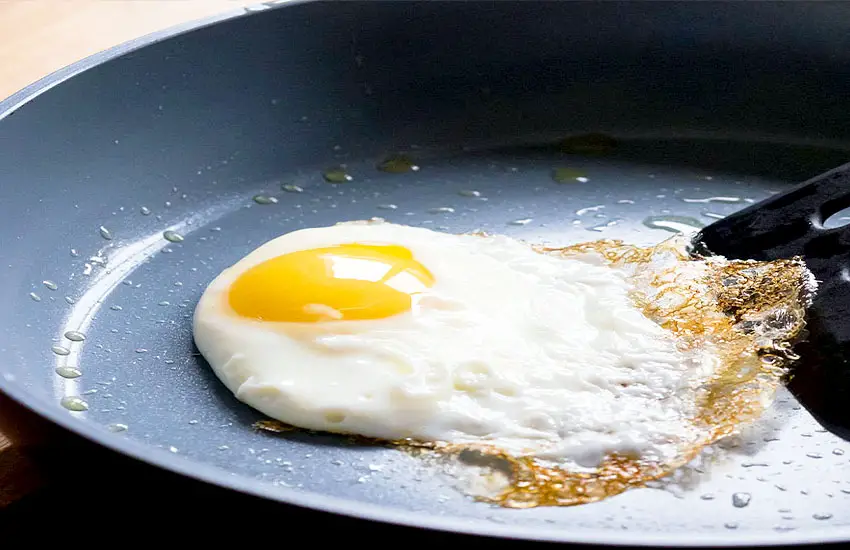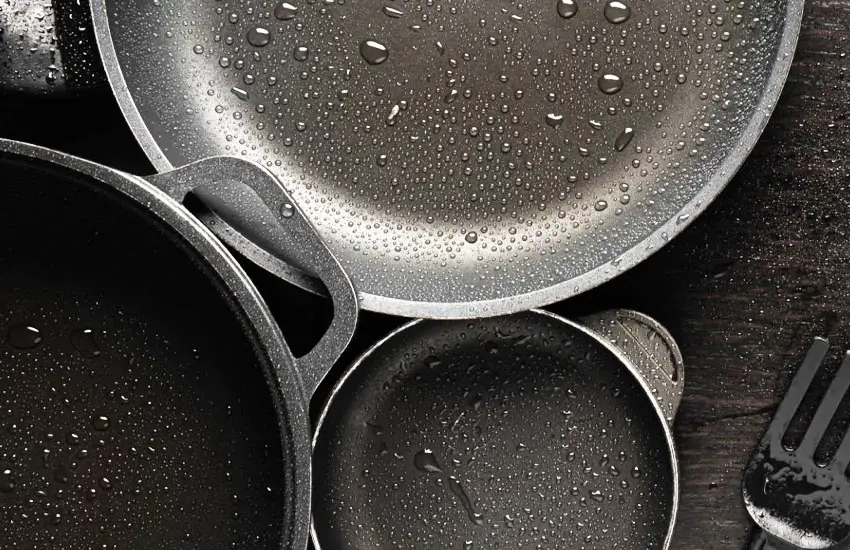As an Amazon Associate, I earn from qualifying purchases at no extra cost to you.
Are Nonstick Skillet Safe for Cooking? Know the Reality!
Do you enjoy cooking in your kitchen? If you do, you’ve probably seen those smooth, nonstick pans that make cooking and cleaning up a breeze. But have you ever wondered if they’re really safe to use? It’s a question that’s been on many people’s minds. Nonstick pots and pans are popular because they make cooking easier.
But there are worries about whether they might be bad for our health or the environment. In this blog post, we’re going to take a closer look at nonstick skillets. We’ll find out if they’re as safe as they seem and separate the truth from the rumors.

Understanding Nonstick Coatings
Ever wondered why food slides off those shiny pans so easily? It’s all thanks to nonstick coatings, like the ones you find on your favorite frying pans. These coatings are like magical shields that prevent your eggs from sticking and make cleanup a breeze.
Nonstick coatings come in different types, but the most common ones are PTFE (also known as Teflon) and ceramic. PTFE coatings have been around for a long time and are known for their super-slick surface. Ceramic coatings, on the other hand, are newer to the scene but gaining popularity for their natural appeal.
So, how do these coatings work their magic? It’s all about science! The smooth surface of nonstick coatings creates a barrier between the food and the pan, making it harder for them to stick together. This means less oil or butter is needed for cooking, which can be great for those watching their fat intake.
But hold on a minute – are these coatings completely safe? That’s where things get a bit tricky. While nonstick pans can make cooking easier, there have been concerns about certain chemicals used in their production. For example, PTFE coatings can release toxic fumes if they’re overheated, which is why it’s important to use them properly and avoid high temperatures.
However, don’t fret just yet! Many manufacturers have taken steps to make their nonstick coatings safer by using PFOA-free materials and following strict regulations. Ceramic coatings are also considered a safer alternative, as they’re made from natural materials and don’t contain the same potentially harmful chemicals.
Potential Health Risks Associated with Nonstick Skillets
When it comes to nonstick skillets, they seem like superheroes in the kitchen, rescuing us from sticky messes and saving us time on cleanup. But like all superheroes, they have their weaknesses. Let’s talk about some potential health risks associated with these slick kitchen companions.

One of the biggest concerns with nonstick skillets is the release of toxic fumes. Picture this: you’re cooking up a storm, and suddenly, you notice a strange smell wafting from your pan. That smell could be a sign that your nonstick skillet is overheating, and when it does, it can release harmful fumes into the air.
These fumes come from a chemical called perfluorooctanoic acid (PFOA), which is used in the production of some nonstick coatings, like PTFE (also known as Teflon). Breathing in these fumes can be bad news for your health, causing symptoms like headaches, nausea, and even flu-like symptoms in severe cases.
But wait, it gets worse! PFOA doesn’t just disappear into thin air – it can stick around in the environment for a long time. That means it can end up in our soil, water, and even our bodies, posing long-term health risks.
Now, before you panic and throw out all your nonstick pans, there are some things you can do to minimize these risks. First off, always use your nonstick skillets at the right temperature. Overheating them is a big no-no, as it can release those nasty fumes we talked about earlier. Stick to low to medium heat settings, and never leave your pan unattended on a hot stove.
Another thing you can do is choose nonstick skillets that are made without PFOA. Many manufacturers have ditched this chemical altogether or have found safer alternatives, so look for pans with labels like “PFOA-free” or “safe for high heat.”
But what if you’re still worried about the health risks of nonstick skillets? Well, you’re in luck! There’s another option on the market: ceramic coatings. These coatings are made from natural materials like silica and clay, so they don’t release the same toxic fumes as PTFE coatings. Plus, they’re more environmentally friendly and scratch-resistant, so they’ll last longer in your kitchen.
Assessing Safety Measures and Best Practices
Now that we’ve talked about the potential health risks of nonstick skillets, let’s dive into how you can use them safely in your kitchen. Just like any tool, nonstick pans can be safe if you know how to handle them properly. Here are some safety measures and best practices to keep in mind:

1. Temperature Control
One of the most important things to remember when using nonstick skillets is to control the temperature. Overheating them can lead to the release of toxic fumes, so it’s crucial to stick to low to medium heat settings.
Avoid using high heat, and never leave your pan unattended on a hot stove. If you’re unsure about the right temperature for your cooking, refer to the manufacturer’s instructions or use a heat-resistant cooking oil.
2. Choose Reputable Brands
When purchasing nonstick skillets, opt for reputable brands that prioritize safety and quality. Look for pans that are labeled as PFOA-free or made with safer alternatives to traditional nonstick coatings.
Doing some research before buying can help you make an informed decision and ensure that you’re investing in a safe and reliable product.
3. Proper Maintenance and Care
Taking care of your nonstick skillets can help prolong their lifespan and prevent potential health risks. Avoid using metal utensils or abrasive cleaners that can scratch the surface of the pan and compromise its nonstick properties.
Instead, use wooden or silicone utensils and gentle cleaning agents to keep your pans in top condition. Additionally, avoid stacking heavy objects on top of nonstick pans, as this can cause warping and damage.
4. Replace When Necessary
Over time, the nonstick coating on your pans may wear off or become damaged, increasing the risk of food sticking and potentially releasing harmful chemicals.
If you notice signs of wear and tear, such as scratches or peeling, it may be time to replace your nonstick skillets. Investing in new pans with intact coatings can help ensure safe and effective cooking in your kitchen.
By following these safety measures and best practices, you can enjoy the convenience of nonstick skillets without compromising your health or safety. Remember to always use caution when cooking with nonstick pans and prioritize proper maintenance to keep them in excellent condition for years to come.
Addressing Common Myths and Misconceptions
Let’s tackle some common myths and misunderstandings about nonstick cookware:
1. Nonstick Coatings Leaching into Food
One common myth about nonstick skillets is that the coatings can leach into your food and pose a health risk.
However, research has shown that when used correctly and maintained properly, nonstick coatings are generally safe and do not leach significant amounts of chemicals into food.
As long as you follow recommended cooking temperatures and avoid using metal utensils that can scratch the surface, you can feel confident that your nonstick pans are safe to use.
2. Ceramic Coatings Being Entirely Risk-Free
While ceramic coatings are often touted as a safer alternative to traditional nonstick coatings, it’s essential to recognize that they are not entirely risk-free.
While they may not contain the same potentially harmful chemicals as PTFE coatings, ceramic coatings can still degrade over time and release particles into your food.
Additionally, some ceramic coatings may contain trace amounts of heavy metals like lead, so it’s crucial to choose reputable brands and follow proper care and maintenance guidelines.
3. Confusion Between PFOA and PTFE
Another common misconception is the confusion between PFOA and PTFE. PFOA, or perfluorooctanoic acid, is a chemical used in the production of some nonstick coatings, while PTFE, or polytetrafluoroethylene, is the material that makes the pans nonstick.
While PFOA has been linked to health concerns and is being phased out of production, PTFE itself is generally considered safe when used correctly.
4. Nonstick Coatings Lasting Forever
Some people believe that nonstick coatings are indestructible and will last forever. However, like any kitchen tool, nonstick pans require proper care and maintenance to ensure their longevity.
Over time, the nonstick coating may wear off, especially if subjected to high heat, abrasive cleaners, or metal utensils. It’s essential to inspect your nonstick pans regularly and replace them when signs of wear and tear appear to maintain safe and effective cooking.
5. Allowing Scratches to Ruin Nonstick Pans:
Many people believe that a single scratch on a nonstick pan renders it useless. While scratches can compromise the effectiveness of the nonstick coating, they don’t necessarily mean the end of your pan’s life.
Minor scratches can often be mitigated by using wooden or silicone utensils and avoiding abrasive cleaners. However, if the scratches are deep or extensive, it may be time to consider replacing your nonstick pan for safer cooking.
Expert Opinions and Recommendations
You might be wondering what the experts have to say about nonstick skillets and their safety. Well, you’re in luck! Health and environmental experts have weighed in on the matter, providing valuable insights and recommendations.
According to health experts, using nonstick skillets can be safe if you follow proper cooking practices and choose high-quality cookware. They suggest avoiding overheating nonstick pans, as this can release harmful fumes. Instead, stick to low to medium heat settings and use caution when cooking with nonstick cookware.
Environmental experts emphasize the importance of choosing nonstick skillets that are made without harmful chemicals like PFOA. They recommend looking for pans labeled as “PFOA-free” or made with ceramic coatings, which are considered safer alternatives.
Additionally, both health and environmental experts stress the importance of proper maintenance and care for nonstick skillets. By using wooden or silicone utensils and gentle cleaning agents, you can prolong the lifespan of your nonstick cookware and minimize potential health and environmental risks.
Overall, experts agree that nonstick skillets can be a convenient tool in the kitchen if used responsibly. By following expert recommendations and staying informed about the latest developments in nonstick technology, you can cook with confidence and peace of mind in your kitchen.
Final Verdict
I hope this article has helped shed some light on the safety of nonstick skillets in your kitchen. By understanding the potential risks, following expert recommendations, and using proper cooking practices, you can enjoy the convenience of nonstick cookware while keeping yourself and your family safe.
